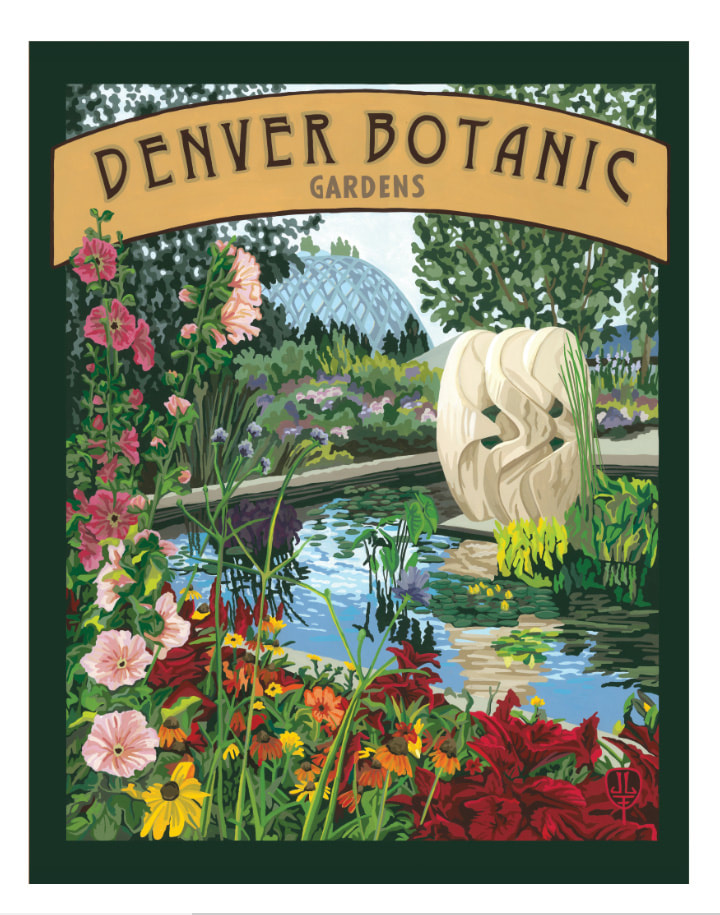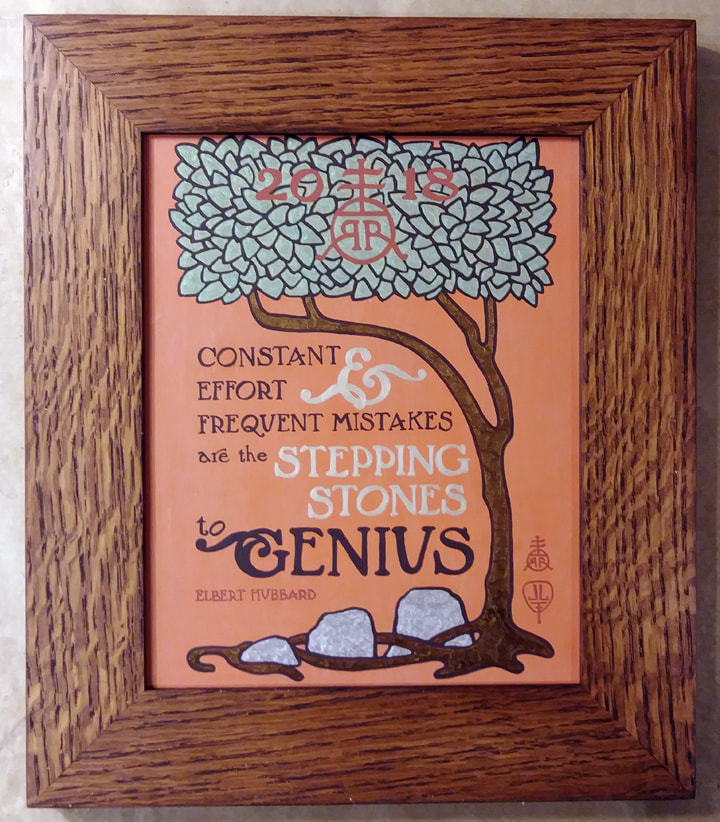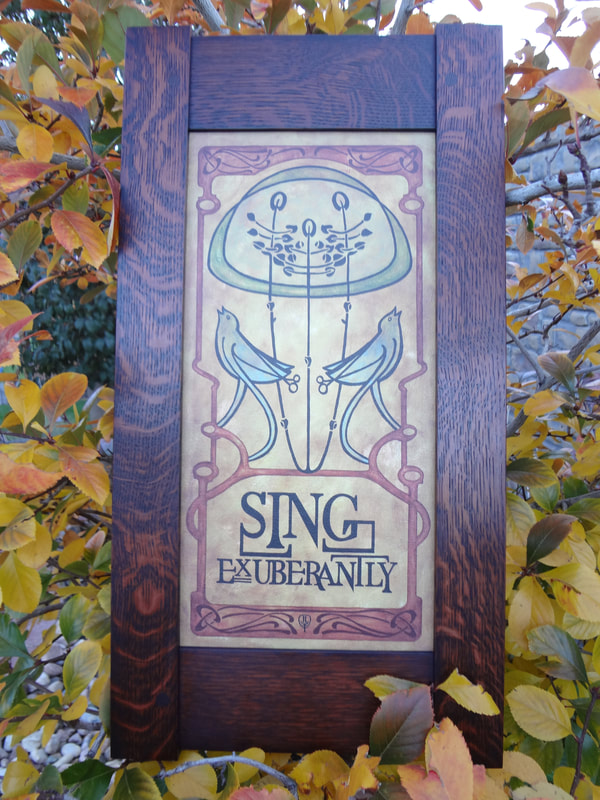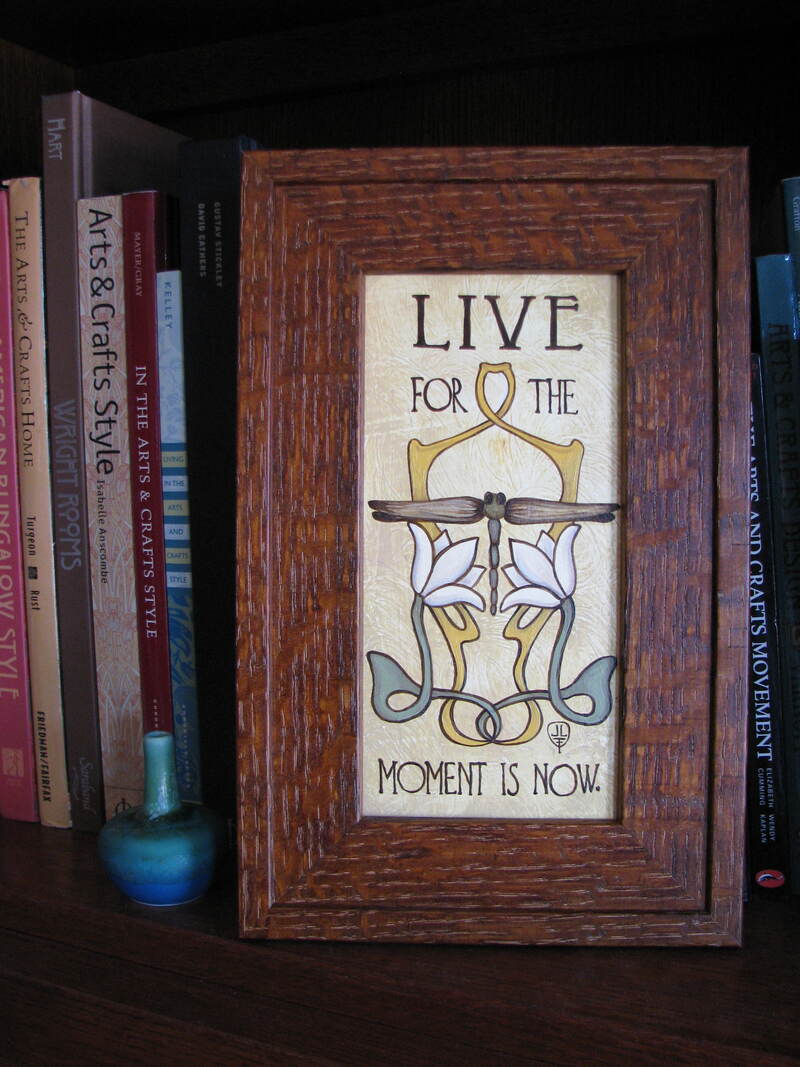| "Denver Botanic Gardens" 16" x 20"Gouache on illustration board by Roycroft Master Artisan Julie Leidel. "Hubbard: Genius" 8" x 10" acrylic on panel by Roycroft Master Artisan Julie Leidel featuring a quote by Elbert Hubbard. This artwork was specifically created for the Roycrofters-at-Large Association as the premium gift to RALA members in 2018. "Sing Exuberantly" 15" x 30" acrylic on panel by Roycroft Master Artisan Julie Leidel inspired by the "The Four" of the Glasgow Style: Charles Rennie Mackintosh, Margaret MacDonald, Francis and Herbert McNair. Written word and illuminated verse by Julie Leidel. "Live" 4" x 8" acrylic on panel by Roycroft Master Artisan Julie Leidel featuring written word and illuminated verse by Julie Leidel. | Often I'm asked "What type or style of art is this that you create?" Truth be told, it's not a simple answer. I usually end up talking about my artistic influences, like the Arts & Crafts Movement (1880-1920), the Art Nouveau Movement (1890-1910), and the WPA era of national parks posters (1930s-40s). But that's not really what they asked. So, I thought I'd do a deeper dive into some of the art world's definitions of artistic expression and categorization that align with the style of artwork I create today. Technically I fall under Contemporary Art, defined by the period in which I am born, creating artwork from the 1970s to the present. Everyone alive painting today is a contemporary artist by this very broad definition. Let's go deeper. Representational Art has been defined as artwork that is reflective of reality. With representational art, the viewer clearly understands what is being depicted; landscape, figurative, physical object or architecture. Representational art goes back to the early Neolithic times, and is the largest category of art created by people over the centuries. Representational art stands in contrast to non-representational art (abstract art & non-objective art) that does not share obvious reference to the physical world, or has a large abstraction from the physical world. There are four main types of Representational Art: Realism, Impressionism, Idealism, and Stylization. Realism describes artworks painted in a realistic almost photographic way. Impressionism (and Post-Impressionism) art is characterized by loose or visible brushstrokes that offer the bare impression of form, many times with unblended color. Idealism depicts subjects in a way that represents ideal beauty or perfection. Stylization is the decorative generalization of figures and objects utilizing techniques like simplification of line, form, and relationships of space and color. Referential Abstraction is an art movement that has spanned over 100 years of American Artwork, and is a newer term that falls under representational art. The Kirkland Museum of Fine and Decorative Art in Denver, Colorado has a large collection aimed specifically at Colorado artwork throughout the 20th and 21st centuries that they categorize as referential abstraction. Here is their definition: "Referential Abstraction denotes art that abstracts something but the viewer can still tell what it is; the abstraction refers to something. Abstraction is the process of removing unwanted or unnecessary information and reducing something to its essential characteristics. In art, this often includes representational, or realistic, detail. Referential Abstraction denotes art that has undergone some of this reduction yet still retains some representational context; the work refers to something concrete and visible to the viewer." I am part of a newer art movement (1970s-present) that can be defined as "Arts & Crafts Revival." This, in part, is defined by my Roycroft Renaissance Master Artisan status within the Roycrofters-At-Large Association (RALA). I believe that the term "Arts & Crafts Revivalist" can include any contemporary artist that takes inspiration from the original umbrella of the Arts & Crafts Movement (Arts & Crafts, Aesthetic, Japonisme, Art Nouveau, Glasgow Style, Jugenstil, Secession, Stile Liberty, Spanish Modernisme, and Wiener Werkstätte) and creates something new within that inspiration. With me contextually placing myself within the Arts & Crafts Revival Movement, the style of my artwork is most aligned with referential abstraction and stylization. My work is about precise line, shape, and color. My brush strokes are hidden within the abstracted shapes that represent the physical world of landscape, figurative, and written word. The text and typography become another important element of my art. It is represented as a precise line and shape just like the rest of the artwork, but when the action of reading is applied to the artwork, idealism emerges in a new way. The result of "reading" my paintings immediately stimulates memories, or uplifts of the human condition through positive messaging. The differences between viewing/admiring my art vs. reading my art for depth of emotion or eliciting memory are both driving forces in what I create. My art could be seen as a modern take on illuminated manuscript (make no mistake, without the Holy influence! Illumination defined as embellishment or ornamentation of the text, initials or borders itself. I reference "illuminated manuscript" because that is it's most common usage from the middle ages that people still know of today.) or maybe it's a form of visual poetry? I usually refer to the written words on my artwork as illuminated verse, or illuminated text, because they are hand-painted. So what type of art do I make? I think I can boil it down to one long sentence: I am an Arts & Crafts Revivalist artist that creates stylized, representational artwork with a tilt towards referential abstraction and idealism through illuminated verse. It makes perfect sense to me. Now, to try to explain it at an art show when you have someone's attention for 30 seconds. A picture is worth a thousand words. I guess that's why artists mostly rely on their art to speak for itself. I think it's less about what the artists sees or means as they create, but more about the connection you have to the art. That's what really counts. |
|
Comments are closed.
|
AuthorJulie Leidel shares news and musings on inspiration for her artwork. Archives
May 2024
Categories
All
|





 RSS Feed
RSS Feed